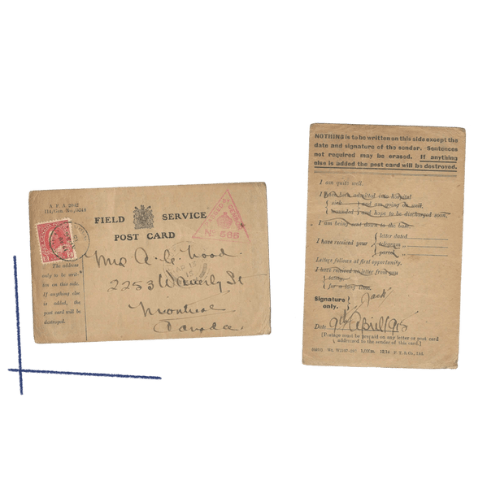This activity will introduce students to the personal stories of individuals and how they experienced the First World War.
Part 1: Class Discussion
If in class, read a real WWI letter out loud. Ask students to analyze the letter in small groups, or as a class. Teacher should emphasize that all letters were read and sometimes censored so that important military information, such as location details or other sensitive, sometimes classified information, was never leaked or intercepted by the enemy.
The letter:
We suggest projecting or sharing an example of a letter home from The Canadian Letters and Images Project: WWI. There are many examples on this database, but here is a suggested letter from a Montrealer. Use the search function if you want to find letters from a specific date (i.e. the date it is in class).
You can also project or share a copy of a telegram received and read it out loud. Ask the class what is the difference between the two documents (letter vs. telegram). Here is a suggested telegram example from The Canadian Letters and Images Project.
Why not also project or share a copy of a Christmas card sent to Canada by a soldier during WWI? Ask students what is the sentiment expressed by the card. How must it have made families at home feel? How it is different, or similar, to a Christmas card today?
Part Two: Individual Analysis
Using a new letter (or the example from class if it hasn’t been used), students will answer the following questions in their student guide:
- Who is writing the document?
- Who is the person writing to?
- What details does the person give about their life or duties in the War?
- What does the person say about their personal well-being?
- What details do they give about their physical surroundings?
- What is the purpose of the letter?
- What facts or information would you like to know that are not said?
Suggestions for finding a new letter:
Give students the link for The Canadian Letters and Images Project: WWI. The archive is organized by name. Have students choose a letter using the first letter of their name. Alternatively, students can use the search bar at the top and enter the current date (e.g. December 13). This should give them a list of letters written that very day over 100 years ago. There are lots of options!
There is no need to print this activity, as it can now be completed directly from your computer! To use the fillable function, be sure to download the PDF.
Other activities you might like
Exhibition- Regiments on the Ridge: 100 years after the Battle of Vimy Ridge
This exhibition provides an overview of the First World War, from its causes to its consequences, with a special focus on the Battle of Vimy Ridge and its importance to the conflict. It is composed of 14 panels.
Memorial Visit
The First World War had a deep impact on Canada and a number of memorials commemorate this event. Students are invited to visit a local memorial and to research its symbols.
Visit One of Our Partner Museums!
Nothing compares to a visit to our partner museums for students to directly interact with history. Guided museum tours and complementary activities make history come alive and will spark your students’ interest!




